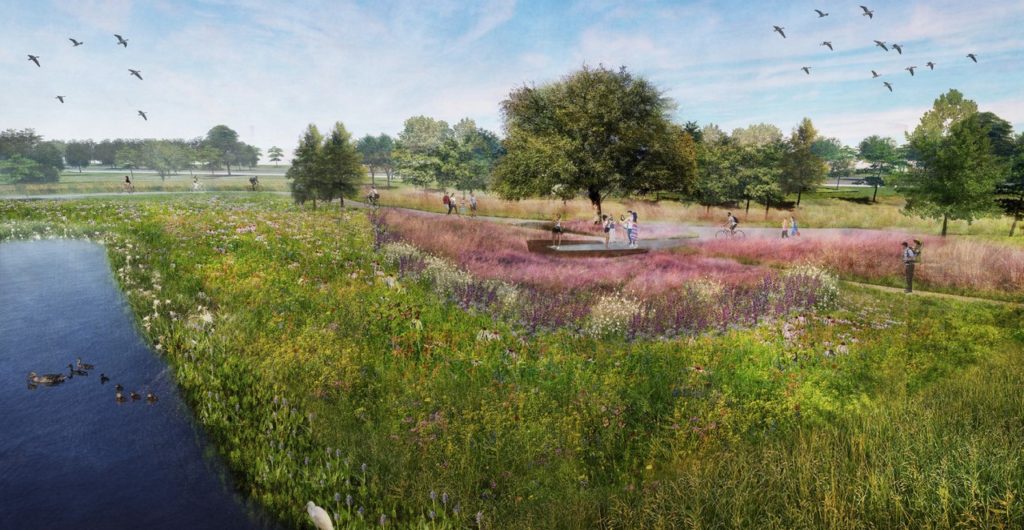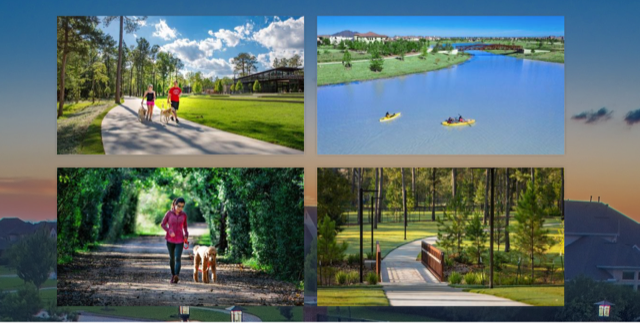By Teri Slavik-Tsuyuki
Community means more than ever now. There are examples of it everywhere as we all work to stay connected socially and emotionally, if not physically. “Home” is the center of our world for the time being, with stay-in-place-orders effective in most states. Community developers, who create the canvas on which those homes are built, are watching real-time synergies among neighbors and reflecting on the critical role of “community” today. What will it mean in the future? How will master planned communities change as a result of our current reality?
Community is physical, virtual and emotional.
Just outside Phoenix in the Estrella master-planned community, developed by Newland, teachers are holding car parades in the community. As the parades wind through the quieter than normal streets, teachers are greeted by their students and parents standing at the end of their driveways with signs like, “I miss you Mrs. Rilley.” There’s little doubt today about the essential value of teachers today. This small moment in time provides a way for students to and teachers to keep their connection real and creates even tighter bonds between parents and teachers.

Amaya Genaro, Vice President of Community Services for Rancho Mission Viejo in South Orange County, California is responsible for Ranch Life community programming. For a few years now, their Ranch Life app has been providing residents access to a community calendar, amenity program information and hours of operation, plus ways to connect with other neighbors. That platform, as a means to connect, just became even more meaningful. “Within days, we were able to launch a ‘positivity thoughts’ section on the app, Boredom Buster Ideas for all ages, Nature at Home, highlighting our open space conservancy with nature-oriented crafts, and STEM class offerings,” says Genaro.
At Bridgeland, a master-planned community outside Houston, developed by the Howard Hughes Corporation, builders are operating by appointment only and finding new and clever ways to engage homebuyers. Newmark Homes, a builder in Bridgeland, is taking this outside the bounds of the community itself while supporting local small businesses who are suffering. They’ve posted downloadable coloring pages of their homes on their website and social media channels. When a buyer colors and shares his or her finished art on social media, Newmark sends the artist a gift certificate to use at a local business to “pay it forward.”
What does this mean for community amenities in the future?
With Easter Egg Hunts cancelled or moved to private backyards, amenities and playgrounds closed, and block parties becoming driveway parties, what does life after coronavirus mean for new community amenities? Newland is doing what they have done so well for years: surveying their customers. Lynneah Hudson, Vice President of Marketing for Newland’s Western/Northwest Region says, “We need to ask the questions. If you could choose a community to live in now, post-COVID-19, what does it look like in terms of amenities, programming, places?” She cites numerous touchpoints in a community, from refilling water bottles, to playgrounds, and even doggie waste bags that may need creative solutions to overcome lingering fears. It will be a balance between a focus on hygiene and providing places for people to get together, gather, and celebrate the human craving for connection.
Smaller scale, neighborhood-focused amenities have been a focus for the last several years. Based on the conversations I had this week, expect that to continue. And always at the top of list of consumer preferences for community amenities, expect to see more focus on trails and outdoor space. Lona Shipp, Director of Marketing at Bridgeland says, “Bridgeland has always emphasized open space, and 28% of our acreage is devoted to it. We are focused on communicating how our communities offer many options for outdoor activities to help maintain both mental and physical health in a time where it’s incredibly important.”

Message Matters, Too
We are all buried in information about COVID-19, almost constantly. With that in mind, community developers are doubling down on their core values and communicating with residents and buyers in ways that show empathy for how everyone is figuring out how to live their lives. Rancho Mission Viejo is doing this by keeping communication short, simple, and not re-iterating all the COVID-19 information. Says Genaro, “There’s too much stuff coming at everyone. We’re making sure our tone of voice and virtual elements remain consistent with the Ranch brand, which is truly the essence of friendship, community support and camaraderie between neighbors.” They are also amplifying ways residents are self-quarantining, showcasing “community” in real time on social media.

Community development is a people business. Think about what people really want to see and hear. When this is over, and life returns to a new normal, home shoppers will have a better chance of seeing themselves living in a community where authentic connections between people are built into the fabric of life and where evidence of those connections helping neighbors get through this together are undeniable. That is at the heart of what community developers do every day and what will make their passion and creativity for creating places more important than ever before.
Things to watch for:
- Personalized concierge sales experiences – watch for a blend of technology and human-enabled ways to demonstrate community to potential buyers, on their terms, as and when they want it.
- New ways to access large signature amenities – will there be a desire for RSVP access, at certain times or for large events to help maintain a feeling of more control, or will the human desire to gather overrule that?
- Tech-enabled ways for communities to deliver events and participation – movie nights, book clubs, art classes taken real-time, online
- Greater integration between homebuilders and community developers during the sales and purchase journey, with virtual tours removing previous points of friction and making the whole experience faster and easier.
- Doubling down on really making outdoor space work for pedestrians, cyclists, and strollers – potentially even influencing sidewalk design and width – and providing connected integrated paths of travel.
Teri Slavik-Tsuyuki is the principal of tst ink, bringing a customer-focused “how might we?” approach to creating communities and brands that connect and engage with how people want to live their lives.



